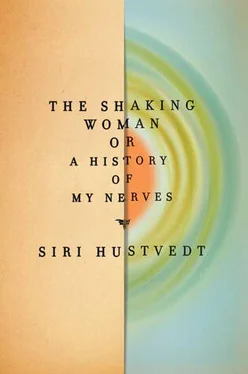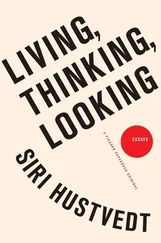THE STORY OF THE SHAKING WOMAN is the narrative of a repeated event that, over time, gained multiple meanings when seen from various perspectives. What first appeared as an anomaly became frightening and emotionally charged after its recurrence. Can we say that my responses over time were psychological rather than neurological? Where do we draw the line? Scientists routinely talk about levels —the neural level and the psychological level. They use a spatial metaphor. At the bottom are neurons. A step up is the psyche. We climb a ladder, not unlike the medieval chain of being. The visible exists on the first rung, and the invisible, psychic stuff on the second. A neuron can be seen. Your thoughts cannot. Are neurons more real than thoughts? Scientists often talk about neural representations. How do neurons represent things? A representation is an image or symbol for something else. How does that work? Is there a stratum brain and on top of it mind, and these two are somehow interconnected? Other scientists and philosophers add a third tier for our global, social, and cultural life — what’s outside us. Isn’t it possible that this visual metaphor is problematic, that the very idea of hierarchical levels is flawed? Can brain, psyche, and culture really be distinguished so neatly? Aren’t we born into a world of meaningful others and things? I do not have an answer to these questions but, like Wall, I ask whether it is possible to isolate an experience such as pain from its context.
On the other hand, I do not think biology should be ignored. My attraction to Merleau-Ponty’s thought is that he, like James, emphasizes the corporeal reality of human existence: “Visible and mobile, my body is a thing among things; it is caught in the fabric of the world, and its cohesion is that of a thing. But because it moves itself and sees, it holds things in a circle around itself.” 176The recent fashion for social construction — the study of how ideas are formed in a culture and shape our thought — has spawned innumerable books with titles such as The Social Construction of X and The Invention of Y. Often these books have a political agenda. By revealing how the idea of womanhood, for example, has been “constructed” and “reconstructed” over time, it may be possible to lift the onus of sexism by showing that femininity is not a static entity but a fluctuating idea subject to the influence of history and society. It would be very hard to argue against this, but sometimes the intense focus on the social turns human beings into floating busts. Although there are hermaphrodites, most of us are born either male or female and there are biological differences between the two sexes, which does not necessarily imply the need to oppress one or the other. When I gave birth to my daughter, I felt my body had taken over the proceedings. Pregnancy and giving birth are, of course, socially constructed. Mary Douglas points out in Purity and Danger that in Lele culture an unborn child is perceived as dangerous to other people in the community, and a pregnant woman must take care not to approach sick people for fear of making them worse. 177Sophie was born in 1987 and, at least in my circles, it was considered a badge of honor to deliver “naturally,” without drugs. Now the epidural is routine. Pain is out. Pain relief is in. “Constructions” vary from culture to culture and change within cultures. But from another perspective, birth is a physical event that is always fundamentally the same. Sex and birth are both culturally generated ideas and facts of nature.
In his book The Social Construction of What ? Ian Hacking discusses psychiatric illness and proposes that there is room for both construction and biology. He points out that classifications affect people. They interact with them, are what Hacking calls interactive kinds . Being labeled a schizophrenic will affect you, and you may find yourself in the subculture of psychiatry because of it, a land unto itself with white-coated physicians, pharmacological interventions, locked wards, dance therapy, and even writing classes that will influence how you think about yourself. This does not mean that there is no inherent biology at work, which goes on entirely unaffected by what is thought about it; a genetic predisposition to schizophrenia would qualify as an indifferent kind, Hacking’s version of the philosophical term natural kind. 178Sometimes, however, as Hacking well knows, how you think does affect your biology. When I do biofeedback I am altering my nervous system. All of this means that hard science is vital. Observing a single cell can reap extraordinary results. Studying the lowest life-forms can tell us something about ourselves. The important position science has come to occupy in the culture is not accidental. As Jürgen Habermas has argued, science has gained its ascendancy in the modern world because it has demonstrated great power over the natural world. 179One need only think of the atom bomb or, on a brighter note, antibiotics.
The language we use is crucial to our understanding, however, and many of the intellectual models used to explain how it is with us human beings are limited, inadequate, or downright obtuse. Categories, borders, distinctions, and metaphors such as ladders, roots, theaters, computers, blueprints, machinery, or locked rooms are both necessary and useful, but they have to be recognized for what they are: convenient images to aid comprehension — which necessarily leave out or misconstrue or distort an ambiguous, shifting reality. It is human to want to pin things down and give them a name. No one really wants to live like Borges’s hero, a person so attentive to the shifting plethora of the phenomenal world that the dog seen at three-fourteen deserves a name different from the one seen at three-fifteen. And yet, the story reminds us that all abstraction comes at a cost. Doctors need diagnoses, names for groups of symptoms, and so do patients. At last, I have a sign to hang on my disparate aches and pains or shakes and wobbles. Or do I?
THE MRI COMES UP WITH NOTHING. My brain looks normal, no swellings or tumors or thinning. I will have to battle with the insurance company to get the second one, on my spine. Of course, a significant percentage of people who have seizures also have normal neuroimaging results. In the Journal of Neurology, Neurosurgery, and Psychiatry, I find a paper titled “Is It Worth Pursuing Surgery for Epilepsy in Patients with Normal Neuroimagining?” 180The authors believe it is, but, of course, they want to scoop out bits of brain that belong to people who are tortured by seizures though their doctors cannot find evidence of a lesion on the MRI results. Am I back at the beginning yet again? I now have a psychoanalyst-psychiatrist and a neurologist treating me, but neither of them can tell me who the shaking woman is.
WHILE HELPFUL, cutting the inside of a person (the neurological and the psychological) off from what is outside him (other people, language, the world) is artificial. The differences revealed by these incisions are a matter of focus, how to see and interpret an illness or symptom. Even if my tremor were hysterical, a form of dissociation, a personal metaphor for the unspeakable or for mourning or for an emotional conflict with my father that I have repressed, which then appeared as a psychogenic seizure, I doubt it would have taken that particular form if I didn’t have a neurological predisposition to it, perhaps because of my feverish tremors as an infant, my seizure as a young woman in Paris before the long migraine, perhaps for some as-yet-not-identified reason. Many people — actors, musicians, surgeons, trial lawyers — are subject to a hand tremor before or at the onset of a performance, and many of them calm the quivering with a drug. My fits may simply be an extreme version of that more prosaic physical manifestation of anxiety. On the other hand, let us say that hidden somewhere in my brain, undetected by the MRI, or somewhere in my unexplored cervical spine area, there is a lesion that could be designated as the cause for shaking. I still don’t believe I would have started shuddering if I had not been speaking about my father or standing on that old ground of memory or if I hadn’t been facing family friends I had known since childhood. I would not have shaken that day if there had not been some strong, if hidden emotional catalyst. Genuine epileptic seizures are often triggered by powerful emotion. And what about the shudder in the Pyrenees? I climbed too fast in the thin air and lost my breath, which sent my already vulnerable system into convulsive motion. Hyperventilation can bring on seizures. Every person has a seizure threshold. Mine might be lower than average. Of course, I may be wrong about all of this.
Читать дальше












